How to make a walk-behind tractor on tracks with your own hands?
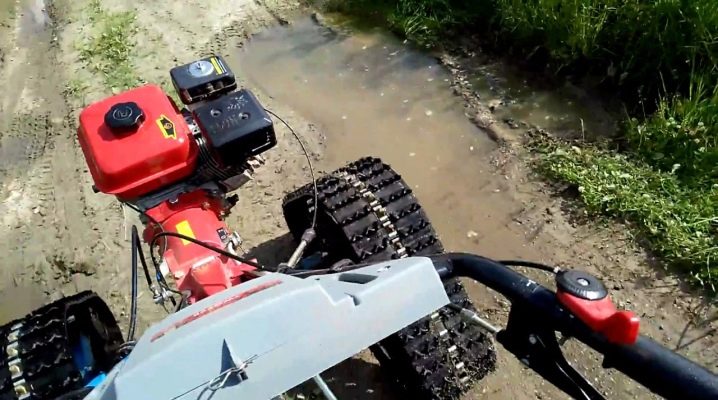
Many craftsmen prefer to improve their walk-behind tractor and make it more functional by installing special caterpillar devices. Of course, they can be purchased ready-made in the store, but it would be much more budgetary and wiser to do it yourself.
Features and device
Tracks for a walk-behind tractor greatly simplify both the transportation of cargo and the movement of the device itself. Due to the fact that the caterpillar mechanism covers a fairly large surface, the walk-behind tractor moves much more evenly, exerts less pressure on the surface and does not get stuck on difficult soils. The tiller on tracks is able to work even in bad weather, and in good weather it becomes even more maneuverable.
The maintenance and use of the tracked module does not cause any particular difficulties for the owners, and it is not difficult to do it yourself. It should be borne in mind that when the walk-behind tractor is equipped with a tracked module, its speed decreases. However, the device's ability to navigate difficult terrain, transport cargo and even clear snow from the area is increasing.
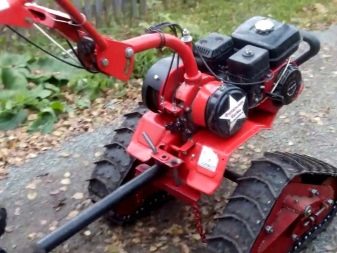
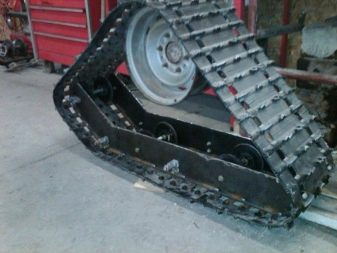
Motoblocks with tracked modules otherwise completely coincide with conventional walk-behind tractors. The engine must be four-stroke with the ability to lock the axles so that the device can turn without making a whole circle. There is also a requirement for water cooling to cope with high loads that cause the motor to overheat. This type is more effective than air. The clutch system, gearbox and gearbox for tracked mechanisms are presented in the traditional version. The walk-behind tractor is controlled on tracks with a handle.
When creating tracks on your own, it is important to understand that if you design them too high, then the center of gravity of the walk-behind tractor will change, and he will begin to experience difficulty turning, and even tilt to one side or another. To prevent such a situation, the second driven axle will have to be made longer by a couple of centimeters. Also, with the help of the bushing, it will be possible to expand the wheelbase that already exists on the walk-behind tractor.
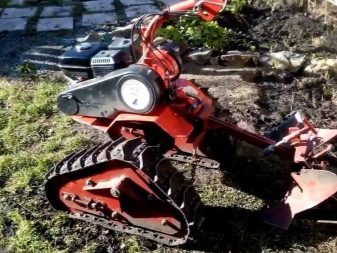

What can be made of?
When choosing a material for tracks, it is important to consider that it should not be excessively heavy. Since the walk-behind tractor itself does not have a powerful engine, it simply cannot cope with weighty material and, most likely, will break. The caterpillar mechanism, as a rule, is made of motorcycle tires, chains, pipes, belts, or a conveyor belt in combination with a sleeve-roller chain.
Most crafters create tracks from car tires - these parts are easily converted to the desired design. It is necessary to choose tires for large trucks, taking into account the existing tread pattern and shape, because the correct pattern will improve grip. It is better if these are spare parts that previously belonged to tractors or other large-sized models.
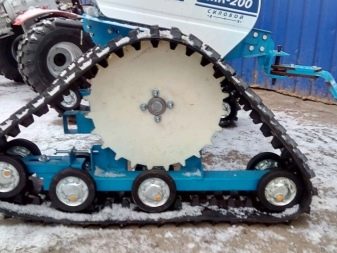

A properly selected tread will be in good contact with wet ground, ice-covered and snow-covered surfaces. In addition to materials for the tracks, to design a full-fledged device, you will need a walk-behind tractor with a gearbox, as well as a pair of additional wheels. If necessary, an additional cart is attached to the walk-behind tractor and, if desired, even on skids to transport goods through deep snow.
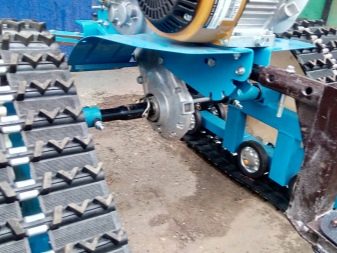
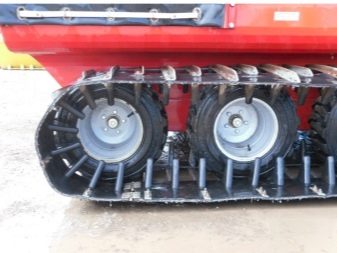
Step-by-step manufacturing instructions
To make a caterpillar mechanism for a walk-behind tractor with your own hands, in addition to the materials used, you will need certain tools: a grinder, and sometimes a drill, a boot knife and a set of screwdrivers, bolts, nuts and wrenches, a welding machine, wire, chains and a sanding belt. Of course, drawings will also be necessary, which are easy to find on the Internet in the public domain.
If homemade tracks are made from car tires, then the first thing the tires are freed from the sides to the state of a running belt - a track for caterpillars. This is easier to do with a well-sharpened knife, for example, designed for working with boots. The adjustment process is lengthy, but it can be accelerated by periodically smearing the blade with a soapy substance.
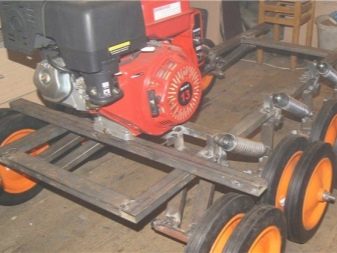
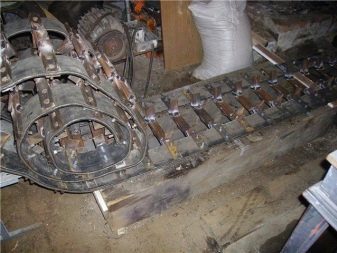
It is more convenient to cut the sides of the tires with an electric jigsaw, which has small teeth. At the next stage, the wrong side of the tire is also corrected: excess layers are removed from it. This should be done when the tape is too dense inside. Such a track attachment made of car parts turns out to be quite durable, since the tire is initially closed, which means that it will be more difficult to damage the tracks during operation. Unfortunately, the available tire width will not give the user the opportunity to use a large surface. However, some craftsmen solve this problem by using multiple tires.
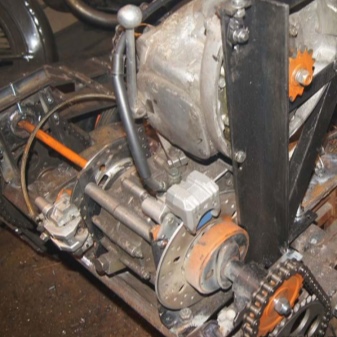
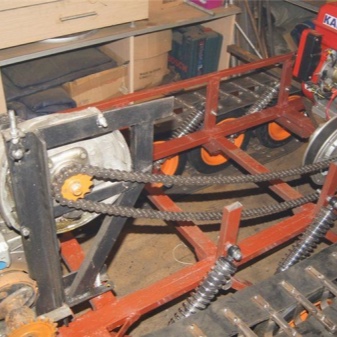
The simplest track module can be made from a conveyor belt and sleeve-roller chains. First, depending on how powerful the engine is, the required thickness of the used belt is selected. This is followed by the processing of the edges, which can begin to shaggy and, because of this, fail earlier. For this, a fishing line is used with a pitch of ten millimeters. The finished edges are then sewn into a ring, with a special hinge, or simply along the end parts.
Despite some primitiveness of the mechanism, it will serve for a very long time. It is important to add that the thickness of the tape must exceed seven millimeters, otherwise the device will not be able to withstand the required loads. The optimal interval is considered to be from eight to ten millimeters.
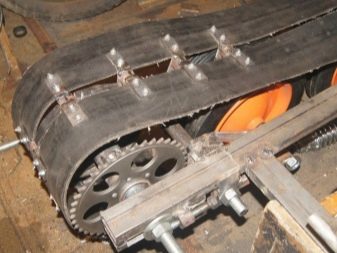

The track module can be made from belts if they have a wedge-shaped profile. It is best to connect the parts with a lug, which is fixed on the straps with screws or rivets. Another common solution is to construct tracks from chains of equal size. Such a versatile part, as a rule, is abundant in any home workshop, so this method is also economical. To make caterpillars, you have to take a pair of equal chains and unclench their extreme links.
Now the two chains can be connected into one circuit, the links can be clamped back and for reliability everything can be welded. For greater strength, the chains can be fastened again with lugs, which, by the way, are also simply made from scrap materials - metal sheets of the required thickness. In general, this part can be not only steel, but wooden and even plastic. In the latter case, wood bars or plastic tubes are used as it. Which material will be most suitable can be determined depending on the purposes of using the walk-behind tractor.
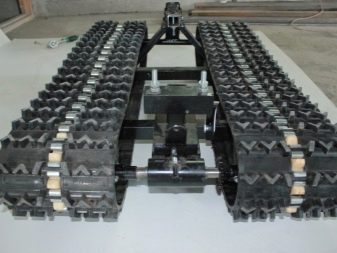
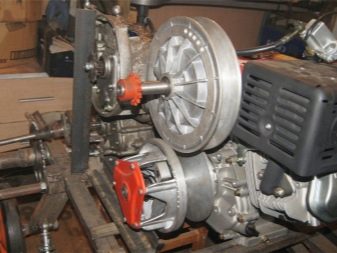
In the event that the cargo expected for transportation does not differ in large weight, the lugs should be made plastic. The same applies to moving devices equipped with weak motors. When a walk-behind tractor is planned to be used as a tractor, and it has a rather powerful engine, steel parts should be preferred.
Sometimes homemade caterpillars are reinforced with pipes, which are welded together. Parts in this case are made of metal and have a rectangular cross-section. In this case, it is recommended to remove the drive shafts from the "Oka", and take the spline part from the "Buran". The equipment must be equipped with brakes that are mounted on the front shafts. This addition allows you to get the device with maximum capabilities.
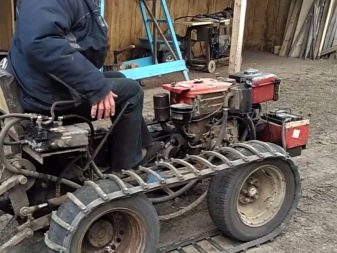
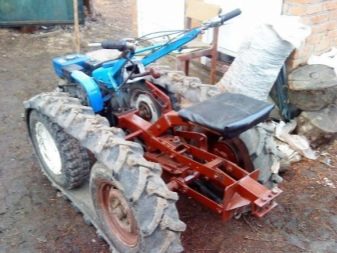
It is worth mentioning that in order to convert a regular walk-behind tractor into a tracked one on the go, you first have to put two additional wheels on it, one on each side. The result should be a four-wheeled structure, on which the tracks are already put on. Some craftsmen prefer to make these additional wheels removable rather than weld on new mountings. This can be accomplished by attaching the wheels to the axle using a flexible or rigid transmission. It is impossible not to mention that it is not necessary to make the tracks yourself - no less economical solution would be to use parts from old equipment, for example, "Buran".
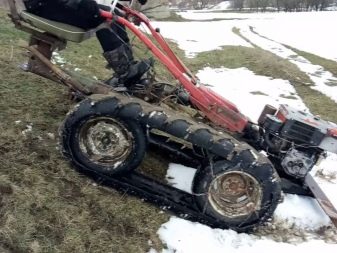

Recommendations for use
Using the tracks of the walk-behind tractor, it is necessary to constantly check how well the chain is tensioned, and also regularly oil the parts whose friction occurs when driving. In addition, it is recommended each time before use to check whether any damage and breaks have appeared on the chain. After the trip, a routine inspection should also be carried out in order to detect any damage or broken hooks in time. When using a walk-behind tractor, you should avoid driving over roots and stone massifs, as well as hemp, otherwise the track module will be torn very quickly.
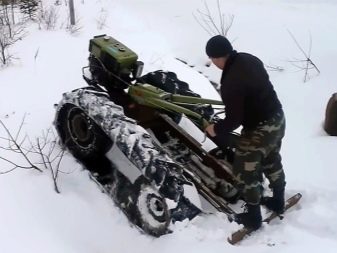

For an overview of the all-terrain motoblock on tracks, see the following video.



































































The comment was sent successfully.